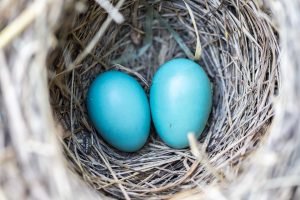If you have ever had the pleasure of watching a bird building their nest, I am sure that you’ll agree that it is a fascinating experience. The ability to see these industrious, tiny creatures working hard in preparation for their imminent chicks is breath-taking.
You might also have noticed the time of year. The worst of the weather seems to be behind us; the days are getting longer and lighter.
If you’re concerned about the birds’ welfare during the colder months, do birds make nests in winter will hopefully go a little way to appeasing your worries.

Nest building is for one purpose; to hold eggs and chicks and keep them safe and warm.
Wild birds innately begin construction as part of the breeding process. For most species, it begins during the spring, although the long-tailed tit might start as early as February. Goldfinches and blue tits are late starters, often waiting until April or May to begin the nest-building process.
No birds build new nests in winter, but that isn’t to say that some nests are unused when temperatures drop.
Table of Contents
Nest building
Garden birds often spend days creating the perfect haven for their families. They use many materials, including twigs, grasses, moss, hair, fur, and feathers. Robins, thrushes, and woodpeckers are amongst the species that line their nests with mud to make it more robust.
In some instances, the male does the work to impress the female and prove his worthiness as a mate, in other species, such as blue tits, the females work alone in preparation for her brood.
Nests are complex structures, built to last for a single mating season. If the pair have more than one brood per season, it is commonplace for them to reline the existing nest before the next eggs hatch.
They often steal materials from broken down, evacuated nests to enhance their own.
Nest recycling
Song thrushes, swifts, and blackbirds are some of the birds that return to the same nesting site each spring. They won’t reuse the remainder of the nest they left in the previous autumn; they build afresh, very close to it.
Swallows behave similarly, they prefer to return to an old nesting spot. They will, however, use any remnants of an old nest, even if not their own. They are larger birds, so building from new is cumbersome, recycling is more convenient.
Most nests don’t survive until winter; their structure isn’t rigid enough. Any that do make it through may well become an overnight stop for groups of birds before their hunt for food resumes at dawn.

Cavity nesters
Many small songbirds prefer to build their nests within the cavities of trees, rocks, buildings. This type of nest is protected from the elements and therefore tends to survive the winter.
Cavity nesting birds roost together in winter, sheltered from the cold, rain, and snow.
Robins, woodpeckers, tawny owls, and members of the tit family use their cavity nests throughout winter. They spend the day hunting for food before returning and remaining overnight.
Nesting in bird boxes in winter
Old bird boxes are the perfect roosting spot on cold winter nights. Yours won’t necessarily be used by the bird that hatched their chicks there, but by numerous other birds to shelter from the cold.
Wrens have a fondness for empty bird boxes and are known to gather in their dozens to share body heat overnight.
Blue tits also make use of boxes to shelter from the winter.
Final thoughts
Although birds don’t make nests in winter, their previously inhabited ones are an integral part of their survival.
Many birds head south in the search for a warmer climate in October or November. At the same time, the UK bird population swells with migrant birds from continental Europe, Scandinavia, and Russia preferring the temperature to their own.
The impressive numbers of garden birds need our help in winter, we should leave bird boxes in situ, and never touch a nest, even after the young have flown.
